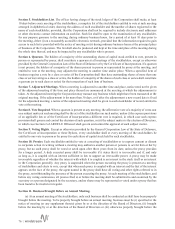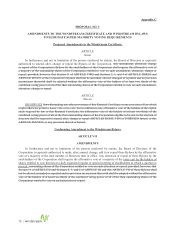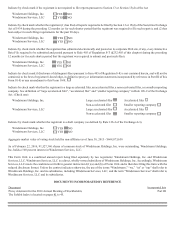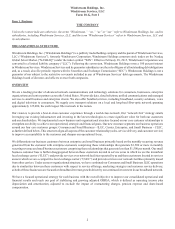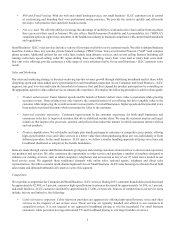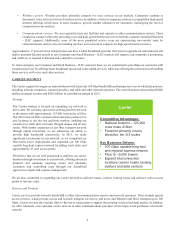Windstream 2015 Annual Report Download - page 88
Download and view the complete annual report
Please find page 88 of the 2015 Windstream annual report below. You can navigate through the pages in the report by either clicking on the pages listed below, or by using the keyword search tool below to find specific information within the annual report.
6
• Wireless carriers: Wireless providers primarily compete for voice services in our markets. Consumers continue to
disconnect voice service in favor of wireless service. In addition, wireless companies continue to expand their high-speed
Internet offerings which does, in some instances, provide another alternative for customers, intensifying the level of
competition in our markets.
• Communications carriers: We are required to lease our facilities and capacity to other communications carriers. These
companies compete with us by providing voice and high-speed Internet services to both the consumer and small business
- ILEC segment. Additionally, some of the more populated service areas are experiencing new-market entry by
communications carriers who are building out their own network to compete for high-speed Internet services.
Approximately 17 percent of our footprint does not have a cable broadband provider. Our focus to upgrade our infrastructure and
deploy premium Internet speeds in our Consumer and Small Business - ILEC markets will improve our competitive positioning
and enable us to respond to demand and competitive pressure.
To retain and grow our Consumer and Small Business - ILEC customer base, we are committed to providing our customers with
exceptional service by offering faster broadband speeds and value-added services, while also offering the convenience of bundling
those services with voice and video services.
CARRIER SEGMENT
The Carrier segment leverages our nationwide network to provide 100 Gbps bandwidth and transport services to wholesale partners,
including telecom companies, content providers, and cable and other network operators. The carrier business unit produced $688
million in annual revenue and $502 million in contribution margin in 2015.
Strategy
Our Carrier strategy is focused on expanding our network to
drive sales. We currently operate the sixth largest fiber network
in the nation with approximately 125,000 route miles of fiber.
Our fiber network links common interconnection points in tier
one locations to our tier two and three markets, enabling our
customers to reach their end users through unique and diverse
routes. With further expansion of our fiber transport network
through capital investment, we are enhancing our ability to
provide high bandwidth connectivity. In 2015, we made
significant investments in our network, as we completed our
fiber-to-the-tower deployments and expanded our 100 Gbps
capable long haul express network by adding route miles and
approximately 45 new access points.
We believe that we are well positioned to stabilize our carrier
business through investment in our network, offering advanced
products and solutions, targeting carrier and wholesale
customers and controlling costs through our disciplined
approach to capital and expense management.
We are also committed to expanding our carrier network to add new routes, connect existing routes and add new carrier access
points to increase sales.
Services and Products
Carrier services provide network bandwidth to other telecommunications carriers and network operators. These include special
access services, which provide access and network transport services to end users, and Ethernet and Wave transport up to 100
Gbps. Carrier services also include fiber-to-the-tower connections to support the growing wireless backhaul market. In addition,
we offer wholesale voice and data carrier services to other communications providers and to larger-scale purchasers of network
capacity.
Carrier
Competitive Advantages:
• National footprint – 125,000
route miles of fiber
• Footprint primarily covers
attractive, tier 2/3 routes
Key Business Drivers:
• 100 Gbps capable long-haul
and regional express network
• Fiber to ~5,000 towers
• Expand interconnection
locations (carrier hotels, landing
stations and data centers)


